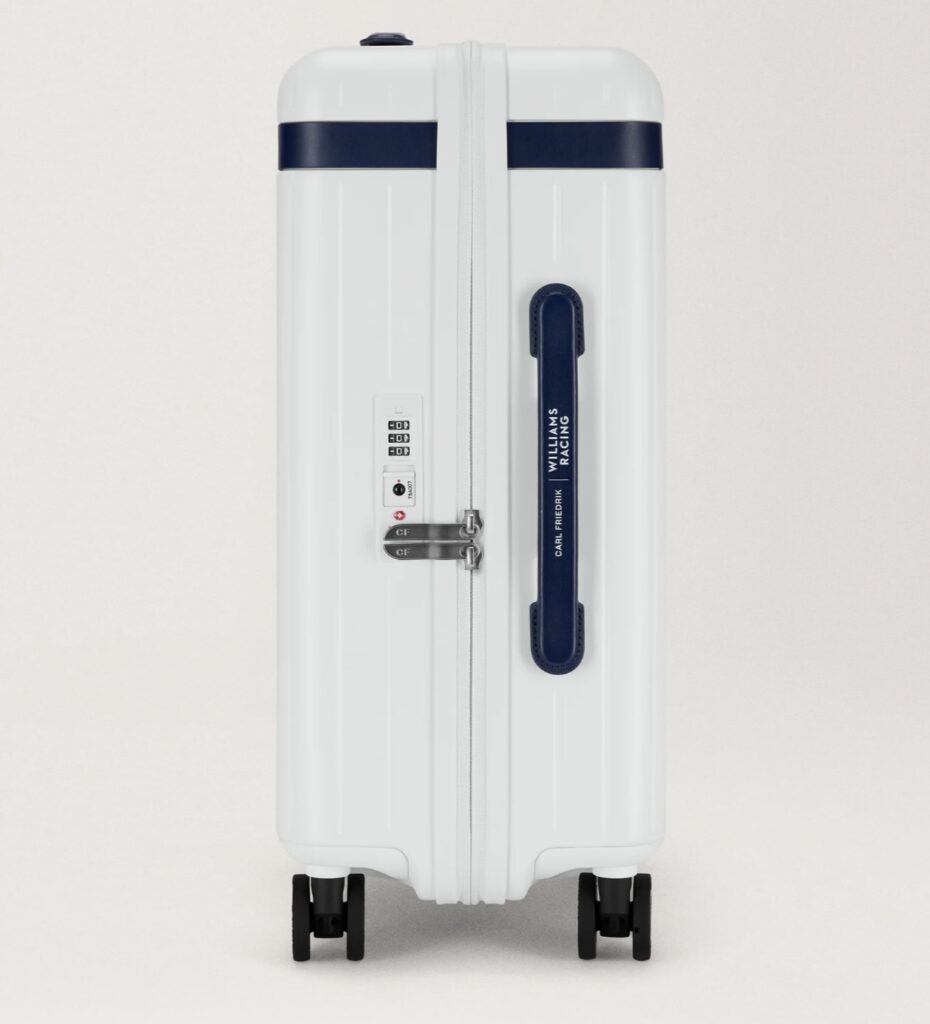The story of luggage has long been told through three pillars—durability, elegance, and function. Rarely does it brush against the adrenaline-soaked world of motorsport. Yet in 2025, Carl Friedrik, celebrated for its refined travel gear, crossed that boundary in partnership with Williams Racing, one of Formula 1’s most storied teams. The result is the Atlassian Williams Racing Core Carry-On, a suitcase that feels less like a travel essential and more like a statement of lifestyle and identity.
This flow is not a gimmick. It captures the shared spirit of two seemingly different worlds: the precision of racing and the craftsmanship of luxury goods. Both thrive under pressure, both value innovation, and both find beauty in design that performs. The carry-on is therefore not just a container for clothes—it’s a performance piece in its own right, equally at home in a pit lane or in a polished airport terminal.
Heritage Meets Technology
Carl Friedrik’s language has always been one of restraint: clean lines, measured details, and an insistence on materials that age with dignity. Williams Racing, on the other hand, carries decades of heritage born on the track—a culture built on grit, speed, and engineering breakthroughs timed to fractions of a second. Brought together, they create a suitcase that balances polish with purpose.
Its exterior—a white polycarbonate shell edged with navy accents—echoes the elegance of both Scandinavian minimalism and Williams’ iconic livery. TSA-approved locks, silent wheels, and precision-tailored compartments complete the picture. Just as every component of a Formula 1 car is designed for aerodynamic efficiency, this carry-on is engineered to endure the turbulence of modern travel.
The Look: Clean, Sharp, Unmistakably Racing
The first impression is striking. A crisp white surface conveys clarity and sharpness, while the navy trims along zippers, handles, and wheel arches call back to the team’s racing heritage. Branding is handled with subtle confidence: Williams Racing stamped into the side handle, Carl Friedrik sitting alongside it.
The matte finish of the shell resists scratches and fingerprints, ensuring that even after long journeys the case carries itself as if fresh from the grid. Security, too, is built into its design—the lock and clasps sit flush, adding a touch of pit-lane practicality to its understated elegance.
The four spinner wheels glide with poise, built with a rubberized coating to dampen sound. Whether pulled across an echoing terminal floor or rattled over uneven pavements, the suitcase handles itself with the assurance of a car holding tight to a corner.
Inside the Case: Efficiency at Its Core
Open the suitcase and the Williams Racing influence deepens. Formula 1 has no time for wasted seconds, and that sense of order carries through here. Two compartments divide the case neatly: one side with a zippered mesh divider for cables, documents, and accessories; the other with a compression flap designed to secure clothing without fuss.
The design is about economy of space. Rather than rigid dividers, flexible panels contour around rolled garments and footwear, making sure no inch is squandered. The deep navy lining, dotted with Carl Friedrik’s motif, lends a quiet refinement while promising resilience. Like a well-organized pit crew, everything has its place, and everything is within reach.
Why Williams?
At first glance, the pairing might raise questions. Why would a heritage-driven maker of travel goods partner with a Formula 1 team? The answer is less about spectacle and more about philosophy. Williams Racing is a team that has thrived not by outspending rivals but by outthinking them, pushing innovation under constraint. Carl Friedrik’s ethos is not so different: timeless pieces designed without compromise, pared down to what matters.
Even the “Atlassian” name feels telling. It nods to the software partner that underpins Williams’ planning and strategy—reminding us that logistics, whether in racing or travel, is about more than speed. It’s about control, preparation, and clarity.
On the Move
A suitcase ultimately proves itself in motion, and this one is built for multiple roles. Its compact form satisfies airline cabin requirements, making it perfect for weekend escapes. For business travelers, its internal structure balances formalwear with tech essentials. For fans heading to a Grand Prix, it quietly signals allegiance without the loudness of team merchandise.
At 3.8kg, it is not the lightest, but that heft feels reassuring—strength over fragility, solidity over compromise. Like the best racing machines, it’s built to last.
Responsibility in Design
The collaboration also acknowledges the responsibility of modern design. Its shell is made from recyclable polycarbonate. Its longevity reduces the cycle of disposable luggage. Repair services extend its life further. In this way, it mirrors Formula 1’s own pivot toward sustainability: hybrid engines, carbon-neutral pledges, incremental steps toward lasting change.
More Than Travel
The Atlassian Williams Racing Carry-On is more than a travel tool—it is a cultural symbol. Owning it aligns the traveler with certain values: respect for heritage, admiration for engineering, appreciation for style that whispers rather than shouts.
It appeals to the professional who insists on efficiency, the fan who wants subtle expression, the design enthusiast who admires clean fusion between sport and minimalism. It’s the difference between wearing a replica jersey and wearing a blazer with a discreet emblem—the latter is a statement of taste.
Against Its Rivals
In the luxury luggage field, comparisons are inevitable. Rimowa, with its German aluminum legacy, sets one benchmark. Away, modern and practical, caters to mass appeal. Tumi offers corporate utility. The Williams Racing case sidesteps these categories, carving its own space as a suitcase that ties a story to its structure. It blends minimalism with motorsport, creating a niche few others can occupy.
A Story Carried
Every piece of luxury thrives on its story. A suitcase is only zippers and panels until it carries with it a narrative. This one does: the urgency of a pit stop, the calm elegance of a Scandinavian studio, the shared pursuit of excellence across two different worlds. At an airport lounge, you don’t just say “It’s Carl Friedrik.” You say, “It’s a Williams Racing collaboration.” That in itself is a form of luxury.
Who It Belongs To
This suitcase is for travelers who value balance: form and function, performance and poise. It is for those who appreciate motorsport but resist the obvious, who see travel gear not as disposable but as an investment. It’s built for the professional who wants a companion for the long term, whether the destination is a conference, a city break, or the paddocks at Silverstone.
Flow
At the crossing point of racing and travel, Carl Friedrik and Williams Racing have created more than luggage—they have created an emblem. The Atlassian Carry-On is a distillation of precision, elegance, and endurance. It is as much about the joy of movement as it is about the mechanics of design.
For the traveler who reads journeys as stories, this case plays the lead role.
No comments yet.










